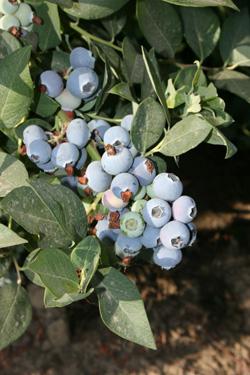Blueberries, growing
-
Blueberry shrubs make an elegant statement in the southern California home garden. The shrubs are relatively low-maintenance once established and produce powerful antioxidants packed in a small but beautiful blue package.

If you want blueberry shrubs to succeed in your home garden, you must satisfy their requirements for:
• low soil pH,
• minimum chill requirement (MCR = the accumulated number of hours between 32°F and 45°F necessary for dormant plants to break vegetative and flower growth), and
• pollination,
as well as the usual irrigation, fertilization, and pruning tasks
Sun
Plant in full sun.
Soil
Blueberry plants grow wild in the forests of the Northwest, including California redwood forests, where decaying leaves produce a highly acidic soil (pH 4 to 4.5) and conditions are usually moist.
Soils in Southern California are generally alkaline and so must be managed to create the conditions that blueberry plants need. To achieve the necessary pH, peat moss and/or leaf mold can be incorporated into the soil before planting; sulfur and aluminum sulfate may also be required. Acidic corrections will probably have to be made on a regular basis since rain will leach out additives and alkaline irrigation water will raise soil pH.
In Southern California, it is easier to maintain the correct pH by planting in a large container. Read more about planting blueberries in containers.
Watering
Blueberry shrubs are shallow-rooted and should not be allowed to dry out, but their roots are very sensitive to standing water so they need good drainage.
Mulch and irrigation are essential for successful plants. Put mulch around the newly set plants soon after planting, being careful to keep it away from the central stem to avoid crown rot. Mulch keeps soil temperatures cooler during summer, reduces weeds, and maintains soil moisture. Acidic mulches, such as rotted pine wood/pine needles and acid-type fertilizers (iron chelate or iron sulfate) will also help to maintain a low pH.Fertilizing
An acid-type fertilizer should be applied at the beginning of the growing season in early spring and at two-month intervals. Fertilizers that are recommended for azaleas, such as cottonseed meal, are also good for blueberry plants.
VarietiesThe relatively recent development of heat-tolerant varieties of blueberries, such as Southern Highbush, has allowed growers to establish a California blueberry industry and home gardeners in Southern California to raise their own crops.
The low-chill Southern Highbush performs well in southern California because they need fewer hours of cold required to set fruit. Southern Highbush blueberries are self-fruitful, but we recommend that two varieties be planted at a time for optimum fruit and flower production.
Note that there are size differences in blueberry cultivars. A 2 to 3 foot high bush, such as ‘Sunshine Blue’, might fit in smaller areas than ‘Oneal’ or ‘Sharp Blue’ which can reach upwards to six feet tall.

